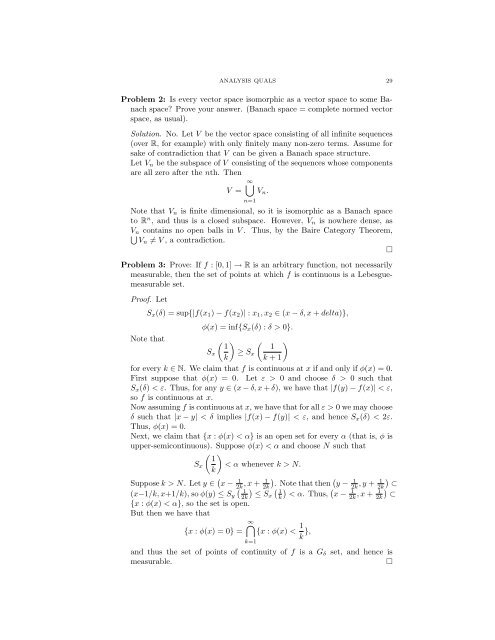ANALYSIS QUALIFYING EXAM PROBLEMS BRIAN LEARY ...
ANALYSIS QUALIFYING EXAM PROBLEMS BRIAN LEARY ...
ANALYSIS QUALIFYING EXAM PROBLEMS BRIAN LEARY ...
You also want an ePaper? Increase the reach of your titles
YUMPU automatically turns print PDFs into web optimized ePapers that Google loves.
<strong>ANALYSIS</strong> QUALS 29<br />
Problem 2: Is every vector space isomorphic as a vector space to some Banach<br />
space? Prove your answer. (Banach space = complete normed vector<br />
space, as usual).<br />
Solution. No. Let V be the vector space consisting of all infinite sequences<br />
(over R, for example) with only finitely many non-zero terms. Assume for<br />
sake of contradiction that V can be given a Banach space structure.<br />
Let Vn be the subspace of V consisting of the sequences whose components<br />
are all zero after the nth. Then<br />
∞<br />
V = Vn.<br />
n=1<br />
Note that Vn is finite dimensional, so it is isomorphic as a Banach space<br />
to R n , and thus is a closed subspace. However, Vn is nowhere dense, as<br />
Vn contains no open balls in V . Thus, by the Baire Category Theorem,<br />
Vn = V , a contradiction.<br />
<br />
Problem 3: Prove: If f : [0, 1] → R is an arbitrary function, not necessarily<br />
measurable, then the set of points at which f is continuous is a Lebesguemeasurable<br />
set.<br />
Proof. Let<br />
Sx(δ) = sup{|f(x1) − f(x2)| : x1, x2 ∈ (x − δ, x + delta)},<br />
φ(x) = inf{Sx(δ) : δ > 0}.<br />
Note that<br />
<br />
1<br />
1<br />
Sx ≥ Sx<br />
k k + 1<br />
for every k ∈ N. We claim that f is continuous at x if and only if φ(x) = 0.<br />
First suppose that φ(x) = 0. Let ε > 0 and choose δ > 0 such that<br />
Sx(δ) < ε. Thus, for any y ∈ (x − δ, x + δ), we have that |f(y) − f(x)| < ε,<br />
so f is continuous at x.<br />
Now assuming f is continuous at x, we have that for all ε > 0 we may choose<br />
δ such that |x − y| < δ implies |f(x) − f(y)| < ε, and hence Sx(δ) < 2ε.<br />
Thus, φ(x) = 0.<br />
Next, we claim that {x : φ(x) < α} is an open set for every α (that is, φ is<br />
upper-semicontinuous). Suppose φ(x) < α and choose N such that<br />
<br />
1<br />
Sx < α whenever k > N.<br />
k<br />
Suppose k > N. Let y ∈ x − 1<br />
<br />
1<br />
1 1<br />
2k <br />
, x<br />
<br />
+ 2k <br />
. Note<br />
<br />
that then<br />
<br />
y − 2k , y + 2k<br />
⊂<br />
1<br />
1<br />
1 1<br />
(x−1/k, x+1/k), so φ(y) ≤ Sy 2k ≤ Sx k < α. Thus, x − 2k , x + 2k ⊂<br />
{x : φ(x) < α}, so the set is open.<br />
But then we have that<br />
∞<br />
{x : φ(x) = 0} = {x : φ(x) < 1<br />
k },<br />
k=1<br />
and thus the set of points of continuity of f is a Gδ set, and hence is<br />
measurable.
















